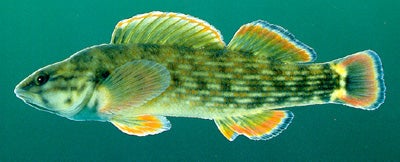REDLINE DARTER
SCIENTIFIC NAME: Etheostoma rufilineatum
CHARACTERISTICS: The redline darter is distinctive in appearance, characterized by a compressed body, pointed snout, deep caudal peduncle, horizontal banding down the sides, and evident dark markings and bars on the cheeks and gill covers. Numerous small red or orange spots occur along the sides of the body between the horizontal lines. Body color is generally tan with variously developed quadrate spots and vertical bars on the sides and nine or 10 dorsal saddles. The breast of males is a deep blue, while the median fins have dark blue margins, white and orange submarginal bands, and gray bands at their bases. All paired fins are orange, and two large yellow spots are present at the base of the caudal fin. See Cope (1870b) for original description.
ADULT SIZE: 1.8 to 3 in (45 to 76 mm)
DISTRIBUTION: Etheostoma rufilineatum is found throughout the Tennessee River drainage and in the Cumberland River drainage downstream of the Rockcastle River. Areas of greatest occurrence and abundance in Alabama are the Paint Rock and Elk river systems, and Shoal, Cypress, Second, and Bear creek creek systems.
HABITAT AND BIOLOGY: Redline darters are found in swift to very swift riffles and shoals beneath and behind boulders and large rocks in small to large streams. In shallower areas, they occur over gravel and cobble shoals and exposed bedrock with scattered gravel or rubble. The redline darter and the rainbow darter, E. caeruleum, are two of the most abundant darter species occurring in the Tennessee River drainage in Alabama. Widlak and Neves (1985) report May through August spawning for a population in Virginia. Our observations indicate spawning from May through June in Alabama. Eggs are buried in sand and gravel (Stiles, 1972). The diet includes midges, blackflies, mayflies, caddisflies, and water mites, which are abundant in its preferred habitat (Bryant, 1979; Widlak and Neves, 1985). Males live three or more years and females live two or more years in Virginia.
ORIGINAL DESCRIPTION: Cope described the redline darter in 1870.
ETYMOLOGY:
Etheostoma means strain mouth, possibly referring to the small mouth.
Rufilineatum means red-lined, in reference to the horizontal side stripes.
The copyrighted information above is from Fishes of Alabama and the Mobile Basin.







